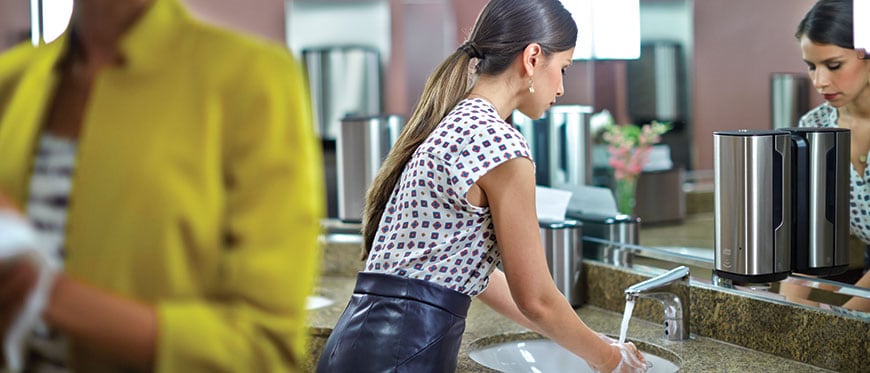Most of the office design trends that get attention are, well … trendy. Open offices.
“Desktopian” visions of height-variable workstations, treadmill desks, or no desks at all. Dedicated collaboration spaces and structures. And supposedly more natural approaches like “biophilic” design.
Many, if not most, of these office trends of late tilt toward attracting and retaining a demanding millennial (and soon, Gen Z) workforce. But what of more humble objectives – such as simply boosting productivity for your workforce in general? It turns out that concentrating on one of the least trendy spaces at work – the bathroom – is a good place for office designers and HR professionals to start if you want to enhance employee output.
Bathrooms may literally be “out of sight, out of mind” for management, but employees say they’re a front-and-center concern. One survey reports that “50% of office workers are unhappy with bathroom facilities and say workplace hygiene affects their productivity.” Correlate that to another study’s finding – that 89% of Americans say the quality of the toilets at work directly impacts how much (or little) they think of their organization – and you can see a serious issue starting to shape up. That’s why it’s important to know what your employees expect, and have a plan to meet or exceed those expectations.
Employees expect bathrooms to be:
1. Well-stocked
2. Clean
3. Plentiful
Well-stocked bathrooms are good – well-thought out bathrooms are better
Common sense says that employees will be dissatisfied if there’s a constant lack of hand soap or toilet paper. But researchers report that they are also concerned with the quality of basic supplies, and even how they are dispensed. For instance, they favor “touchless” design, for reducing contact with bacteria – so that no-touch faucet or paper towel dispenser that you’ve been considering for cost savings should also contribute to employee satisfaction.
Clean means caring
Clean bathrooms are a given, right? Not according to 39% of office workers, who say that their facilities are not always properly maintained. You can improve that satisfaction number at your organization by examining both how, as well as how often, your bathrooms are cleaned. Beyond simply planning for your maintenance staff to clean more frequently, you can also equip them to clean more efficiently, via better training and provision of the right tools and supplies for the task.
Plenty of bathrooms keeps employees (and regulators) happy
And finally, better bathrooms, and the improved productivity that comes with them, start by design. If you’re designing a new space, or planning the redesign of an existing office, the number and placement of the restrooms should be a prime concern.
When planning the number of bathrooms, there is a temptation to strictly follow local building code specifications, which may simply be the number of bathrooms required for a certain amount of space. In a multi-story space, however, that could lead to the total number of required bathrooms being located on just one floor. Needless to say, while this might save money, it could also result in a multi-floor office with workers forced to walk, or ride an elevator, much farther than they would like. As a situation like this would waste employee time and good will, placement with easy access for all should be kept in mind to boost both worker satisfaction and productivity.
Of course, not all agree with the above. The late Steve Jobs famously favored centralized bathroom placement at Apple, to encourage chance encounters and unexpected interactions as a spark to creative conversation and out-of-the-cubicle thinking. This approach still has many adherents, particularly in the tech sector, but some researchers beg to differ. One even acknowledges that centralized bathrooms do encourage interaction, but also concludes that “those interactions aren’t necessarily productive.” He even says that “too much interaction can backfire,” especially when it interrupts what is very private, and often urgent, personal business.
So while better bathrooms may not be the top of the trend list for office design, they should be kept top of mind for anyone concerned with healthy, happy and productive employees.
